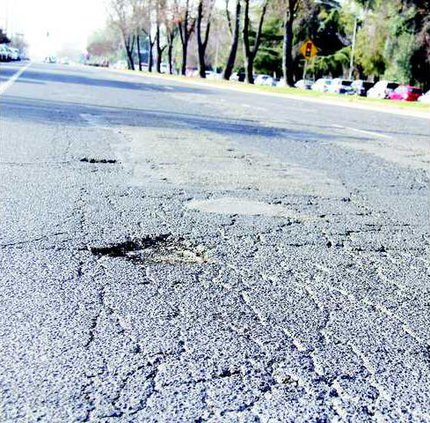The recent drop in gasoline prices may be good for families looking to save money at the pump, but it's taking funding away that the City of Turlock could use to fix the city's failing roads.
The Turlock City Council heard a report on the status of the city's roads on Tuesday and potential funding sources that could go to the much-needed repairs.
The measurement system used to gauge the condition of the city's roadways, the Pavement Condition Index, ranges between 0 (very poor) and 100 (excellent). The city's average PCI at the end of 2015 was 64, almost 20 points away from what is considered a good level.
According to Development Services Director and City Engineer Mike Pitcock, it would take $51 million for the City of Turlock to make the repairs needed to get the roads to a PCI of 80 within one year. And the longer the City waits to fix the roadways, the more roads need repaired and the costs increase.
"Early on there's a quick degradation of the roadway...then it flattens out for a awhile, you get to the 75 percent level of life, and then it drops off drastically. We don't want to get to that point," said Pitcock during Tuesday's City Council meeting. "It's easier and cheaper to get to these roads sooner."
The gas tax, federal grants and assessment districts are the three main ways Turlock pays for road repairs, and the money just isn't there to bring all of Turlock's roads to a satisfactory level.
Pitcock said that the City receives approximately $750,000 a year in federal funding, which goes to projects on the city's arterial roadways. To put that amount in perspective, Pitcock said the project to repave Monte Vista Avenue from Geer Road to Crowell Road cost $1 million.
The money the City receives in gas taxes is tied to the price of gasoline, so as the price at the pump falls, so does Turlock's road funding.
Most residents of newer neighborhoods in town pay higher taxes through an assessment district, which is used specifically for the maintenance of roads and other public areas where they live.
Creating new assessment districts in older neighborhoods is one way the City could raise more money for road repairs. Council member Steven Nascimento asked Pitcock to prepare a report on how new assessment districts could be formed, what they might look like and how much money that would raise to repair roads for each of those new districts.
Mayor Gary Soiseth voiced his support for the proposed spending formula for the Stanislaus Council of Government's countywide road tax, which could be on the November ballot.
The spending formula includes 50 percent of funds dedicated to local streets and road repair of existing roads and 27 percent for regional projects to be determined by local jurisdictions.
As the City continues to seek ways to fund road repairs, one particular street will be the topic of a public meeting set for 6 p.m. Wednesday at City Hall.
The City of Turlock is hoping to make a good impression on drivers coming into the downtown area with a revamp of W. Main Street between Highway 99 and Lander Avenue.
The idea of the redesign is still in its infancy, but city officials are eager to hear the public’s opinions and concerns about the proposed project.
The W. Main Street corridor from the freeway to downtown was never intended to be the busy thoroughfare that it has become and city officials want to consider other options that would benefit the traffic flow and improve safety along the route.
W. Main Street from the freeway to Lander Avenue is a mix of business and homes, some of which are among Turlock’s oldest residences. Motorists are subjected to a bumpy drive on a street that narrows down to one lane in each direction midway through the mile-long stretch. It is a site of frequent traffic backups as drivers attempt left turns or navigate the increased pedestrian traffic during school drop off and pick up times at Osborn Two-Way Immersion Academy at W. Main and Soderquist.
City officials will unveil a few “conceptual ideas” for the corridor and want the community’s input on the ideas and other concerns for the area.
“I want to hear from the residents of the West Main Street neighborhood," Soiseth stated in a news release. "This corridor's improvement is more than just a beautification project. With the increased use of West Main Street as an entrance into our downtown, we now have major infrastructure repairs that can no longer be delayed."
The community meeting will include city staff providing additional information for homeowners on the HUD funded programs for grant and loans to assist them in improving their homes along the West Main corridor or in any other part of Turlock.
"West Main Street has historically been a visitor's first impression of our community,” Soiseth stated. “It's our intention to make that first impression a great one. When Turlock invests in our older neighborhoods, we attract new businesses, decrease crime, and improve community cohesion. Wednesday's workshop will allow us to work collaboratively with residents of this neighborhood and throughout the city to create a vision of a restored West Main Street corridor."
— Sabra Stafford contributed to this report.





